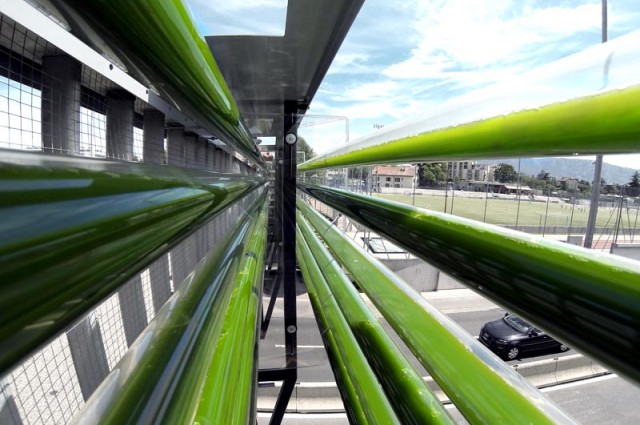Paradigm Shift
This Amazing Algae Farm Absorbs Highway Air Pollution

Algae are amazing and very diverse plant-like microorganisms. Some of the species may contaminate the marine environment, when the colonies of algae grow out of control and release toxins into the ocean. Other species can be used to produce highly efficient biofuel and alimentary products. Some can even be harmful to the human brain, infecting it with a virus that can slow down the cognitive functions.
This interesting microorganism inspired a group of Dutch and French designers, who proposed to set up an algae farm on top of a highway in Switzerland. At first sight this idea may seem odd, but, in fact, it is a brilliant way to filter the pollution in the urban areas, simply because the algae produce huge amounts of oxygen and absorb carbon dioxide from the atmosphere in the process of growth.
The international design team called Cloud Collective presented their concept at a recent garden festival in Geneva, which was aimed to adorn the urban landscape with a touch of nature. The idea was to build an algae farm that would use sunlight together with the emissions of carbon dioxide from cars to produce oxygen and thus purify the air in the polluted urban areas.
“We focus on the character of the site and try to prove that even these locations of highways and car dealers – despite their anonymous and generic character – can play an important role in the production of food and biomass,” write the Cloud Collective designers in their website. “The functioning and the placement of this bioreactor signals practices of the future: food production in an urban environment, the conservation of green space and the reinterpretation of existing infrastructures.”
The system works in quite a simple way: the algae are cultivated inside long transparent tubes equipped with pumps, filters and solar panels, which help the process of maturation. Once the algae are fully matured, they can be used as raw material for a number of different products, such as medications, nutrients, cosmetics and biofuel.
We can only hope that designers all over the world will get inspired by this amazing concept and will come up with new ideas on how to transform their cities into better, healthier and greener environments. You can learn more about how the system works from this video:
ABOUT THE AUTHOR
Anna LeMind is the owner and lead editor of the website Learning-mind.com, and a staff writer for The Mind Unleashed.
photo credit: Cloud Collective
Typos, corrections and/or news tips? Email us at Contact@TheMindUnleashed.com
